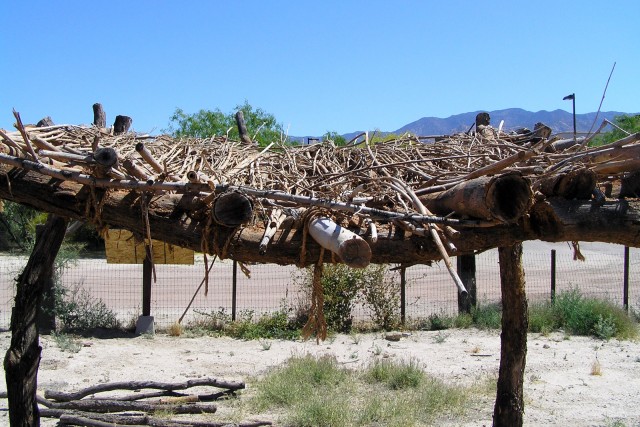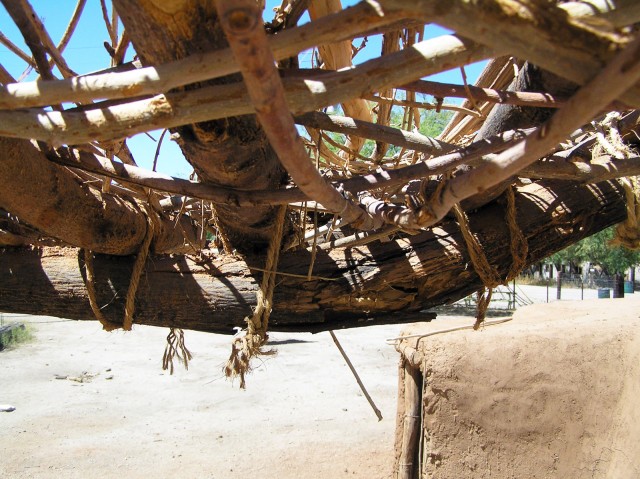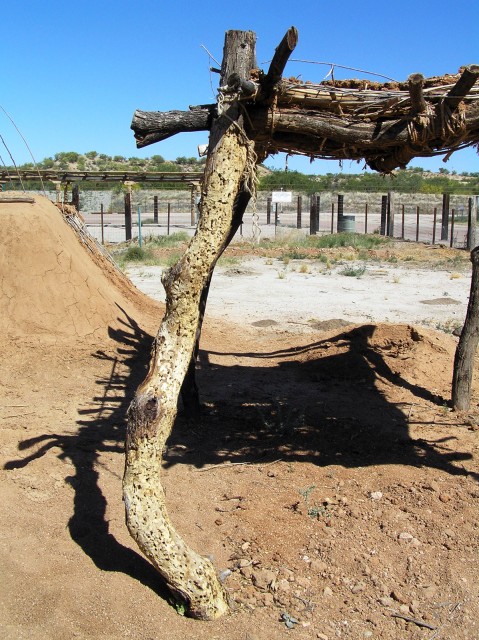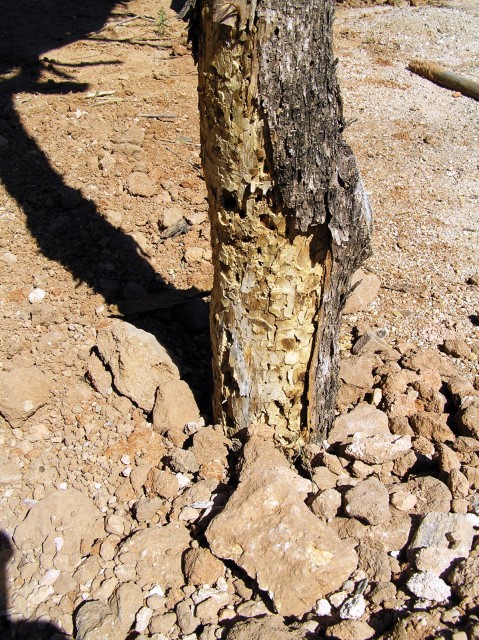- Home
- >
- Preservation Archaeology Blog
- >
- Are You an Entomologist or a Pest Control Expert? ...
One of the interesting things I have noticed out at the replica pithouse at Steam Pump Ranch in Oro Valley, Arizona, is the amount of termite damage to the ramada we built next to the pithouse. We built the ramada of mesquite. The four main support poles and all the roof beams showed considerable termite damage. The outer white wood of most of the logs was thoroughly riddled with holes, and some logs had quite a few holes into the inner dark wood. Two of the roof beams were so chewed up that they had cracked and broken. The weight of the adobe on the roof when wet added to the failure of the termite-riddled beams.


Oddly, at least to my mind, the pithouse itself has very little visual evidence of termite damage to the ponderosa pine logs used for its main support beams and all the leaners around its edges.
We did not implement any kind of termite control to the ramada or the pithouse. Do termites prefer mesquite? Is pine not as tasty?
|
|
|
Possible reasons for the difference in infestation:
- We removed the bark from the pine, but did not remove bark from the mesquite.
- The pine logs had dried quite a bit before they were set into the ground.
- The mesquite logs were freshly cut and still green. Did this make the wood easier for the termites to eat?
- The pine logs were cut green and likely had sap in them as they dried. Perhaps termites do not like the taste of the pitch?
- The species of termite present has an affinity for one kind of wood and not the other.
I’m looking forward to your answers, comments, or suggestions! Thanks.
Allen has openings in his upcoming flintknapping classes. Click here to find out more.
4 thoughts on “Are You an Entomologist or a Pest Control Expert? We Have Questions…”
Comments are closed.
Explore the News
Related to This
-
Project Hands-On Archaeology



This just in from entomologist Alexander Yelich via email:
I work at the UA in the entomology department, and although I do not currently study termites, I have in the not so distant past (2003-2007). I thought I might be able to help with some of your termite questions, or at least get you pointed in the right direction.
The most common structural-pest species of termite is called Heterotermes aureus, the Desert Subterranean termite. They are ground-dwelling termites, and MUST have ground contact in order to have a sustained infestation of any above-ground wood. Other local termite species are either surface-feeding (Gnathamitermes spp.) which form mud sheets and feed on the surface of plant materials (grass, wood, cacti skeletons) but do minimal structural damage, or various dry-wood termites, which are not as common in but can form a colony in dry wood without any ground contact.
My thoughts about why the mesquite logs were damaged (by termites and/or other invertebrates) while the pine logs were not, is probably a function of the immediate ecosystem they were in. Mesquite wood is indigenous and plentiful in the lowlands of the Sonoran desert, and since this is where the ramada was erected, there are naturally more predators around that will eat it. This could be any combination of termites, beetles, bees and even ants. Since the pine logs are not a regular, naturally occurring type of wood in the lowlands, there are probably far less invertebrates that would consider it a viable food source. When I studied termites, there was a termite baiting system (which shall remain nameless) that relied on large pine dowels as a bait to initially detect termite activity. This system was very effective in the eastern and northern US, but didn’t work at all in our desert southwest. This is probably because pine isn’t something that the lowland species of termites consider palatable compared to their traditional foods like cacti skeletons and desert tree woods. (Some local termites are host-specific, but let’s not get me started).
Also, resources in desert ecosystems are pretty limited, and if there is food to be had, those with the right appetite WILL find it. The fresh-cut mesquite may have given off gases or other plant-stress cues as it decayed that got certain invertebrates more excited than kids hearing an ice cream truck. Wood-boring beetles, carpenter bees, termites and who knows what else may have all taken a shot at the mesquite and whatever other woods they found there that they thought was tasty. Perhaps if the mesquite wood had been aged and dry before using it, it’s chemical ‘screams’ would not have been heard by as many hungry invertebrate predators? The pine would probably be eaten after it had aged longer (like the studs in a home) and was the only thing left. I suggest that it was more than termites eating your ramada because of the look of the damage on the logs…subterranean termite damage is typically a series of thin, linear-ish channels along the grain of the wood, whereas beetles and carpenter bees chew larger, meandering tunnels and then have emergence holes that go against the grain of the wood when they emerge as adults (think of a submarine’s emergency breach maneuver.
It’s always a pleasure to read about your projects using the technology of the past, and I hope I was able to be of some help! If you have any other questions, feel free to contact me at your convenience.
Best regards,
Alex Yelich
Laboratory Manager, Tabashnik Lab
University of Arizona, Dept. of Entomology
It’s hard to tell by the photos, but my brain wants to interpret the mesquite closeup as buprestid (or possibly cerambycid) damage. Those are two families of beetles which feed in the phloem (the moist and highly nutritious layer just under the bark) and pupate in the xylem (the wood), facing out. The buprestids leave tightly packed, fine grained frass (which I think archaeologists call poop). The cerambycid frass is coarser, sometimes described as excelsior like. Palo verde beetles, with which you might be familiar, are cerambycids. You may have some carpenter bees, also. They don’t consume wood for food, but rather excavate tubular galleries in which they lay eggs and provision the future larvae with stores of pollen and nectar. The carpenter bee infestations I’ve seen in southern California which have been damaging enough to cause structural collapse were present for years. Thus it is less likely that carpenter bee galleries caused your structural failure. The entry/exit holes are large, circular, and about 1/2 inch in diameter. The adults are frequently seen feeding on flowers, and are big and black or sometimes golden. You can find photos on the web. Also, Forestryimages.org and/or bugwood.org should have photos of the insects and damage. If you could bring some of the damaged wood (hopefully with adult beetles in it) someone at the entomology museum at U of A http://www.uainsectcollection.com might be able to tell you what it is. If it is buprestids or cerambycids, the wood may have been infested when the trees were cut. This would jive with leaving the bark on (keeping those beetle larvae protected from dessication, birds, and lizards). The pines may be attacked at some point by termites, but I do not have much expertise on those.
I wish I could come see it. The insect damage looks pretty neat.
By the way, my specialty is forest insects, pathogens, and their relationships with their hosts.
Laura Merrill, Ph.D.
By the way, I forgot to mention that buprestids and cerambycids feed extensively in the xylem (wood) as well as the phloem. The newly hatched larvae may feed in phloem because their small mandibles can deal with it more easily than the wood, and it is more nutritious (phloem stores as well as transports photosynthates). Please don’t let my fondness for buprestids and cerambycids prejudice a real diagnosis. There are lots of other insects which consume wood. If you take or send material to U of A, include bark and wood with exit holes.
It has been a treat to look at your photos and think about phytophagous insects.
My name is Marie Thackara and I am an undergrad student at University of Washington. I am doing research into the relationship between termite activity and the impact on potential archaeological sites. We are running into stratigraphy issues at a site and I am hoping to find out what your final results were in your research. I look forward to hearing from you. ~Marie